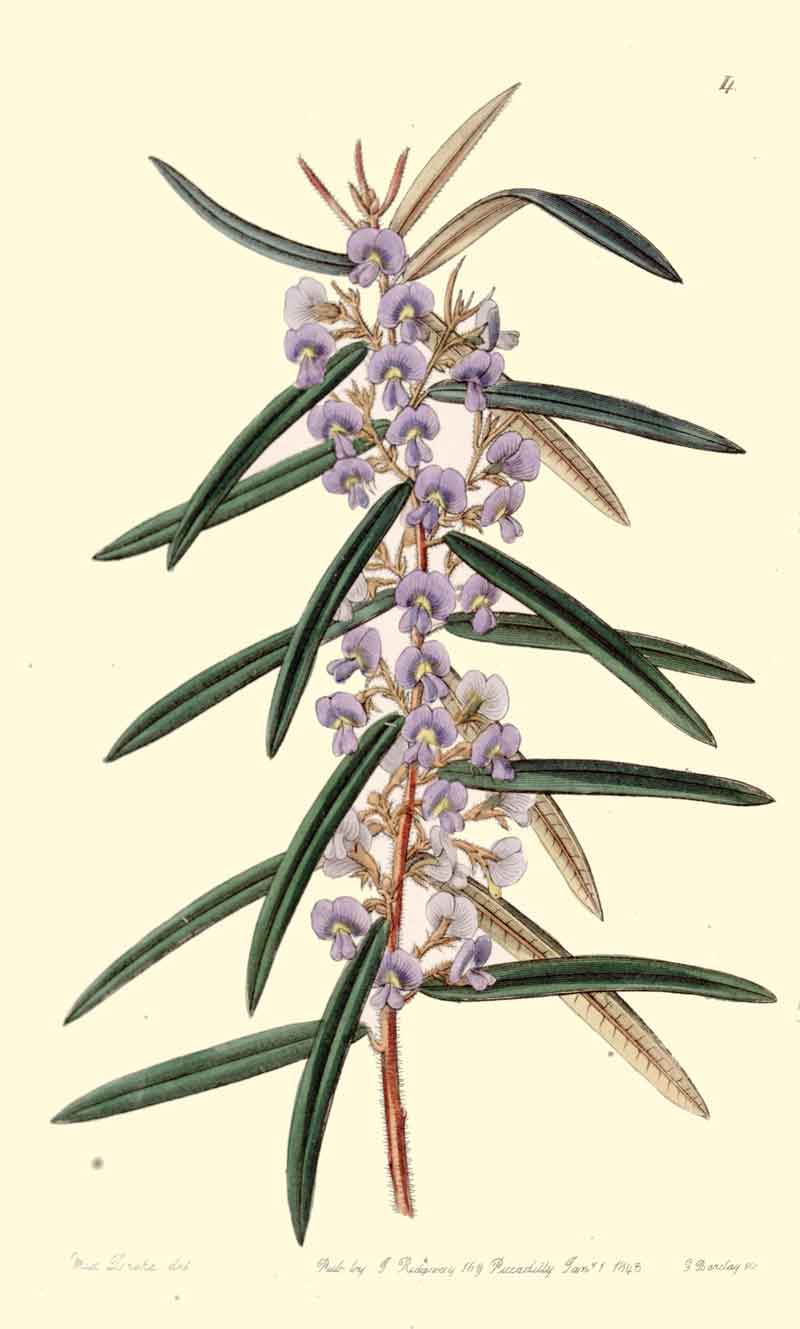
Classification System: APG IV
Superregnum: Eukaryota
Regnum: Plantae
Cladus: Angiosperms
Cladus: Eudicots
Cladus: Core eudicots
Cladus: Rosids
Cladus: Eurosids I
Ordo: Fabales
Familia: Fabaceae
Subfamilia: Faboideae
Tribus: Brongniartieae
Genus: Hovea
Species: Hovea longifolia
Name
Hovea longifolia R.Br., 1812
Synonyms
Hovea lanigera Lodd. ex Steud.
Hovea longifolia f. albiflora Domin
Hovea longifolia var. aspera Ewart & B.Rees
Hovea longifolia subvar. cana Domin
Hovea longifolia var. normalis Benth.
Hovea longifolia subvar. subacuta Domin
Hovea mucronata A.Cunn. ex G.Don
Hovea racemulosa Benth.
Hovea villosa Lindl.
Phusicarpos longifolius (R.Br.) Poir.
Distribution
Native distribution areas:
Continental: Australasia
Regional: Australia
New South Wales
References: Brummitt, R.K. 2001. TDWG – World Geographical Scheme for Recording Plant Distributions, 2nd Edition
References
Primary references
Brown, R. in W. T. Aiton, 1812. Hortus Kewensis; or, a Catalogue of the Plants Cultivated in the Royal Botanic Garden at Kew ed. 2, 4:275.
Links
Govaerts, R. et al. 2020. Hovea longifolia in Kew Science Plants of the World online. The Board of Trustees of the Royal Botanic Gardens, Kew. Published online. Accessed: 2020 Oct 29. Reference page.
International Plant Names Index. 2020. Hovea longifolia. Published online. Accessed: Oct 29 2020.
Tropicos.org 2020. Hovea longifolia. Missouri Botanical Garden. Published online. Accessed: 29 Oct 2020.
Catalogue of Life: 2021 Annual Checklist
USDA, ARS, Germplasm Resources Information Network. Hovea longifolia in the Germplasm Resources Information Network (GRIN), U.S. Department of Agriculture Agricultural Research Service. Accessed: 09-Oct-10.
Vernacular names
English: Rusty Pods
Hovea longifolia commonly known as rusty pods,[2] is a flowering plant in the family Fabaceae, endemic to eastern Australia. It has purple pea flowers, linear leaves with rusty felt like hairs on the lower surface.
Description
Hovea longifolia is a shrub to 3 m (9.8 ft) high and stems with brownish to grey, short, densely matted, curled or more or less straight hairs. The leaves strap like to linear, 2–8.5 cm (0.79–3.35 in) and 2–9 mm (0.079–0.354 in) wide, flat to slightly arched, blunt to sharp at the base, margins curved or rolled under, apex rounded or nearly pointed on a petiole 2.5–4 mm (0.098–0.157 in) long. The upper surface green, shiny, smooth, hairless except for a dense row of midrib hairs, and the lower surface densely covered in yellow-brown curled, felt like hairs. The inflorescence is a cluster of 1–3 flowers on pedicels 4–6 mm (0.16–0.24 in) long. The purple standard petal is twice the length of the calyx, with darker purple veins and a yellow centre, the wings and keel shorter. Flowering occurs from August to October and the fruit is an oval shaped pod 10–15 mm (0.39–0.59 in) long.[2]
Taxonomy and naming
Hovea longifolia was first formally described in 1812 by Robert Brown and the description was published in Hortus Kewensis.[3][4] The specific epithet (longifolia) means "long leaved".[5]
Distribution and habitat
Rusty pods grows in shady, moist situations near stream banks and slopes, mostly from Narooma to Judge Dowling Range in New South Wales.[2]
References
"Hovea longifolia". Australian Plant Census. Retrieved 12 July 2021.
Thompson, I.R. "New South Wales Flora Online: Hovea longifolia". Royal Botanic Gardens & Domain Trust, Sydney, Australia.
"Hovea longifolia". Australian Plant Name Index.
Brown, Robert (1812). Hortus Kewensis. London: Longman, Hurst, Rees, Orme, and Brown. p. 275.
Les Robinson – Field Guide to the Native Plants of Sydney, ISBN 978-0-7318-1211-0 page 81
Retrieved from "http://en.wikipedia.org/"
All text is available under the terms of the GNU Free Documentation License

